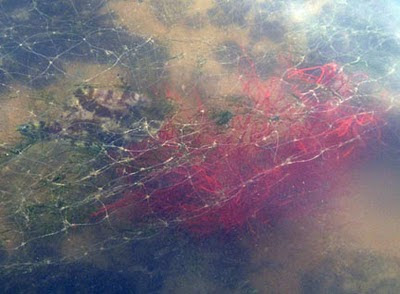There is a tiny sliver of natural shore at Tuas teeming with marine life. My last visit to this shore was in April.
Particularly abundant are Thorny sea cucumbers (Colochirus quadrangularis), as well as Orange sea cucumbers.
There were lots of Haddon's carpet anemones (Stichodactyla haddoni) too. I also saw several purple sea cucumbers.
I noticed the different kinds of sea cucumbers have different coloured feeding tentacles:
Oh dear, I found two of these sea cucumbers that didn't look healthy at all. I have no idea what they are or what is going on.
A little Blue swimming crab (Thalamita sp.) near a patch of Zebra coral (Oulastrea crispata).
Sheryl and I are fascinated to come across a Striped hermit crab (Clibanarius infraspinatus) which has just moulted!
We can tell it's a moult because the eyes are transparent!
There were some patches of Button zoanthids (Zoanthus sp.), I saw a small clump of Sea mat zoanthids (Palythoa tuberculosa). Also several colonies of Flowery disk corals (Turbinaria sp.) and one colony of Favid coral.
Tuas to me is sea fan heaven. And today, they seem to be back in force. With many small colonies of Candelabra sea fans, some Flat branch sea fans and Skinny sea fans. There were also several different kinds of hydroids (Order Hydrozoa).
I saw many small Ball soft corals and small colonies of Flowery soft corals (Family Nephtheidae). I also saw some Common cerianthids (Order Ceriantharia).
Kok Sheng did a much more thorough survey of the shore including the Beacon area. He'll share about his sightings soon on his blog.
While Sheryl and I looked at the seagrasses at Tuas as part of TeamSeagrass monitoring, Kok Sheng documented the shore. And Bee Yan had a look for crabs in the small cluster of mangroves on the shore. She is doing a revision of the Singapore mangrove crab checklist and wants to survey all the mangroves in Singapore to find out the diversity of mangrove crabs. Despite her packed schedule, I'm glad she found time to visit this little patch of mangroves at Tuas.
Oh dear, Sheryl and I found no seagrasses in the area of study. However, there were lush seagrasses outside the study area! The seagrasses have seriously moved. More about the seagrass situation at Tuas on the TeamSeagrass blog.
But we did see many different kinds of seaweeds, the most abundant being the Big coin green seaweed (Halimeda sp.) with small clumps of other green seaweeds.
Sadly, we came across a very VERY long driftnet. It must have been about 400m long! As I was trying to remove the net, I got pricked on the finger by this White-spotted rabbitfish (Siganus canaliculatus). Ouch! Now I know what the descriptions mean by the fish having poisonous spines. There was a sharp pain that went down my finger to my wrist, which dulled to an acid ache in about 15 minutes. A few hours later, there's no more pain.
It was a heartache to see this net trap not only fishes but also entangle the beautiful marine life on the shore.
We only managed to remove about 100m of this net before we had to leave. More about the net on the Project Driftnet blog.
Thanks to Sheryl of Merck for arranging for us to visit!
The evening low tides have started with a vengeance. For the next five days, back-to-back field trips to more amazing shores of Singapore! Trying to document what we have, and dealing with the many threats we see there.















